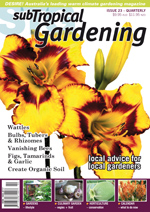Normally associated with Christmas on the northern hemisphere, due to flowering season aligning with the festive season, Euphorbia pulcherrima actually flowers as the day light gets less. In other words, as autumn (fall) turns into winter the amount of sunlight reduces and this stimulates the plant into flowering.
Commercial production nurseries artificially stimulate this day length shortening with the use of shade covers. The benefit to us is that we can get flowering poinsettias most of the year, but they always look their best in winter.
These plants love the sun and do well in part shade. They benefit from a savage pruning each year around summer and love a boost of fertiliser in spring and autumn.
These plants have been bred for vibrant colours, colour patterns and ‘multi-petals’ so the choice is quite extensive.
It is important to note that the colour ‘petals’ we see are actually modified leaves called bracts. The true flowers are small bulbous structures generally near the base of these coloured bracts.
These plants are regarded as easy to grow in warm climates but may need some frost protection in cooler climates.


{ 2 comments… read them below or add one }
Can anyone offer me some simple advise regarding growing pointsettia’s from cuttings in a sub tropical, coastal area. I live in Mozambique – Africa. To my great frustration – 1 cutting from 20 survived. Everyone tells me they are sooooooooo easy to grow from cutting! Any help gratefully received.
Hi Jill, take cuttings well after the flowering period – it appears most poinsettias going into a mild dormant stage after flowering. Just before they put on new growth you can take cuttings then. Alternatively early summer. Reduce the number of leaves on the cutting (about 10-15cm long) as too many leaves will result in excessive transpiration. Allow cuttings to naturally seal the wound. Alternatively, treating cuttings is normally not essential but to improve strike rate, use a rooting hormone powder/gel or plain honey. The cutting media should be well drained (eg. third peat, third perlite, third sand). Excessive watering at this early stage often results in rotting of the cuttings.
I hope this gives you a starting point.